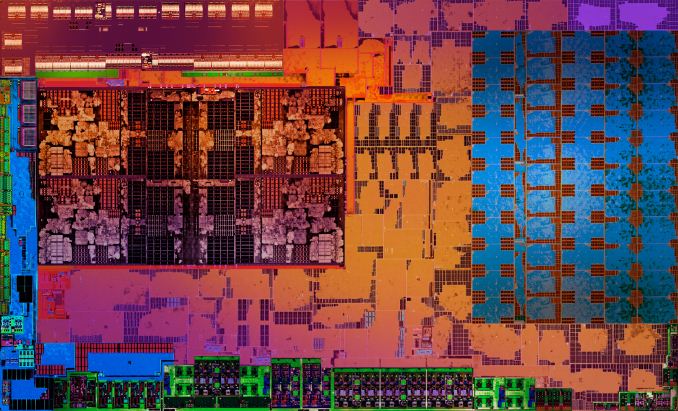CPU Design Guru Jim Keller Joins Intel; Completes CPU Grand Tour
by Ryan Smith on April 26, 2018 1:15 PM EST- Posted in
- CPUs
- Intel
- SoCs
- Jim Keller

For long-time AnandTech readers, Jim Keller is a name many are familiar with. The prolific microarchitectural engineer has been involved in a number of high-profile CPU & SoC projects over the years, including AMD’s K8 and Zen CPUs and Apple’s early A-series SoCs. Now after a stint over as Tesla for the past couple of years, Intel has announced that they have hired Keller to lead their silicon engineering efforts.
After rumors on the matter overnight, in a press release that has gone out this morning, Intel confirmed that they have hired Jim Keller as a Senior Vice President. There, Keller will be heading up the 800lb gorilla’s silicon engineering group, with an emphasis on SoC development and integration. Beyond this, Intel’s press release is somewhat cryptic – especially as they tend not to be very forward about future processor developments. But it’s interesting to note that in a prepared statement included with the press release, Dr. Murthy Renduchintala – Intel’s Chief Engineering Officer – said that the company has “embarked on exciting initiatives to fundamentally change the way we build the silicon as we enter the world of heterogeneous process and architectures,” which may been seen as a hint of Intel’s future direction.
What is known for sure is that for most of the last decade, Keller’s engineering focus has been on low-power hardware. This includes not only his most recent stint at Tesla working on low voltage hardware, but also his time at Apple and PA Semiconductor developing Apple’s mobile SoCs, and even AMD’s Zen architecture is arguably a case of creating an efficient, low-power architecture that can also scale up to server CPU needs. So Keller’s experience would mesh well with any future development plans Intel has for developing low-power/high-efficiency hardware. Especially as even if Intel gets its fab development program fully back on track, there’s little reason to believe they’re going to be able to duplicate the manufacturing-derived performance gains they’ve reaped over the past decade.
As for any specific impact Keller might have on Intel’s efforts, that is a curiosity that remains to be seen. Keller’s credentials are second to none – he’s overseen a number of pivotal products – but it bears mentioning that modern processor engineering teams are massive groups working on development cycles that span nearly half a decade. A single rock star engineer may or may not be able to greatly influence an architecture, but at the same time I have to imagine that Intel has tapped Keller more for his leadership experience at this point. Especially as a company the size of Intel already has a number of good engineers at their disposal, and unlike Keller’s second run at AMD, the company isn’t recovering from a period of underfunding or trying to catch up to a market leader. In other words, I don’t expect that Intel is planning on a moment of Zen for Keller and his team.

One of Jim Keller's Many Children: AMD's Raven Ridge APU
Though with his shift to Intel, it’s interesting to note that Jim Keller has completed a de facto grand tour of the high performance consumer CPU world. In the last decade he’s worked for Apple, AMD, and now Intel, who are the three firms making the kind of modern ultra-wide high IPC CPU cores that we see topping our performance charts. Suffice it to say, there are very high-profile engineers of this caliber that these kind of companies will so openly court and/or attempt to pull away from the competition.
For those keeping count, this also marks the second high-profile architect from AMD to end up at Intel in the last 6 months. Towards the end of last year Intel picked up Raja Koduri to serve as their chief architect leading up their discrete GPU development efforts, and now Jim Keller is joining in a similar capacity (and identical SVP title) for Intel’s silicon engineering. Coincidentally, both Kodrui and Keller also worked at Apple for a time before moving to AMD, so while they haven’t been on identical paths – or even working on the same products – Keller’s move to Intel isn’t wholly surprising considering the two never seem to be apart for too long. So it will be exciting to see what Intel is doing with their engineering acquisitions over the coming years.
Source: Intel










70 Comments
View All Comments
mode_13h - Friday, April 27, 2018 - link
Perhaps mixing CPU, GPU, FPGA, etc. in the same package, but perhaps those dies are also fabbed at different manufacturing nodes.So, maybe intel takes their iGPU off die and gets adequate yield on just the CPU cluster at 10 nm. Then, they have the GPU die still made on 14 nm.
patrickjp93 - Saturday, April 28, 2018 - link
Likely the other way around given 10nm isn't so kind on clock speeds.patrickjp93 - Saturday, April 28, 2018 - link
HSA is dead. Get over it. OpenMP, SyCl, and HPX were doing what HSA is doing 10 years ago, and they do it better without code bloat.patrickjp93 - Saturday, April 28, 2018 - link
And heterogeneous as in one die may be 14nm, another 10nm, or Hell 22nm to put the chipset on the package.baka_toroi - Thursday, April 26, 2018 - link
WHY DID YOU HAVE TO GO WITH THAT WHORE, JIM!? YOU BETRAYED ME! :'(CajunArson - Thursday, April 26, 2018 - link
Don't you think you're a little late?He worked for Apple and quit there YEARS ago.
alphasquadron - Thursday, April 26, 2018 - link
These people being at such a high level in their companies, don't they know specific trade secrets of their previous companies that could be used in the new company for efficiency gains? Do they just block that out of their head when thinking of designing a new processor?casperes1996 - Thursday, April 26, 2018 - link
That's why this is California! They have relatively loose rules on all this. He can't explicitly implement ideas from competing products, but he can use general concepts for inspirationmode_13h - Friday, April 27, 2018 - link
I think the idea is that AMD patents all of his ideas they use and discuss. Then, he can't just go and use those same ideas at Intel, because Intel will try to patent them and discover that they're already patented.Being a top performer, he can't afford to hold back any applicable ideas from his current project, because he's got a reputation to protect. Zen wouldn't be what it is if everyone didn't bring their A game.
jjj - Thursday, April 26, 2018 - link
The other very interesting bit is that if he left Tesla, he was likely done with his part and Tesla should have its own silicon in a not too distant future.There were also some rumors about Tesla working with AMD but , AMD or not, Tesla having its own silicon is gonna be way interesting as Tesla is maybe the most focused on machine vision. They are aiming much higher than others in this area as they don't want to count too much on other sensors.